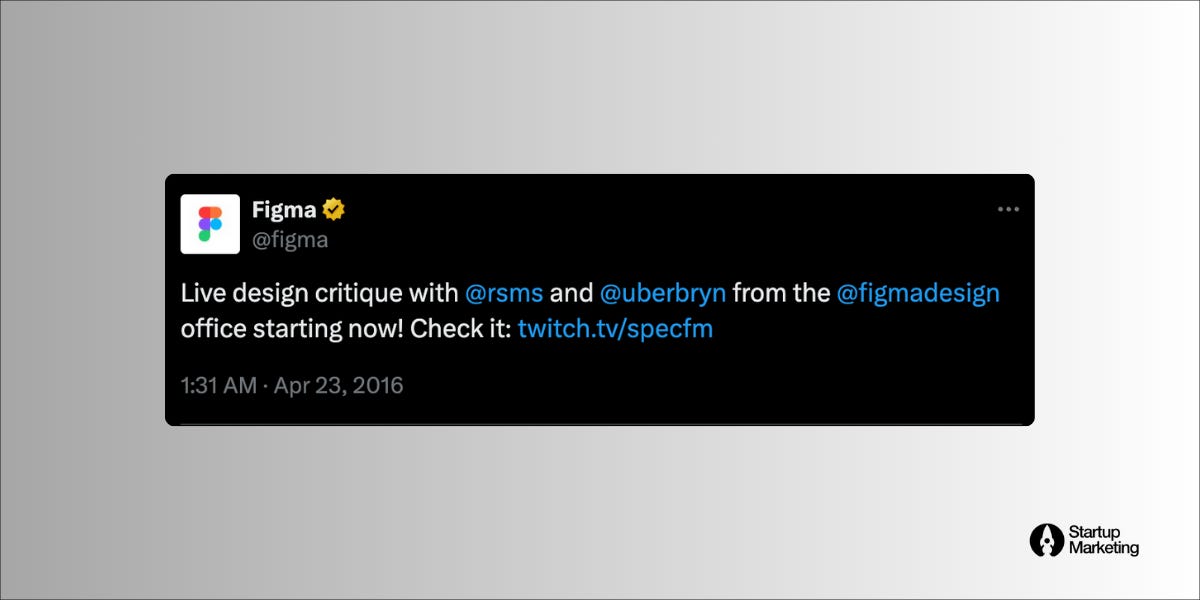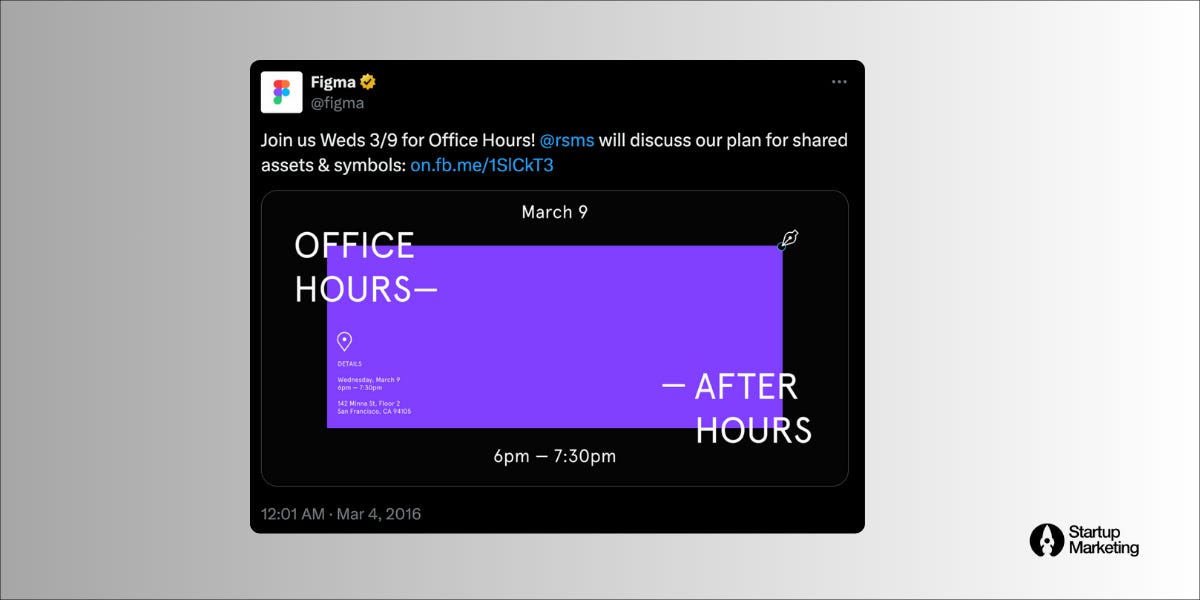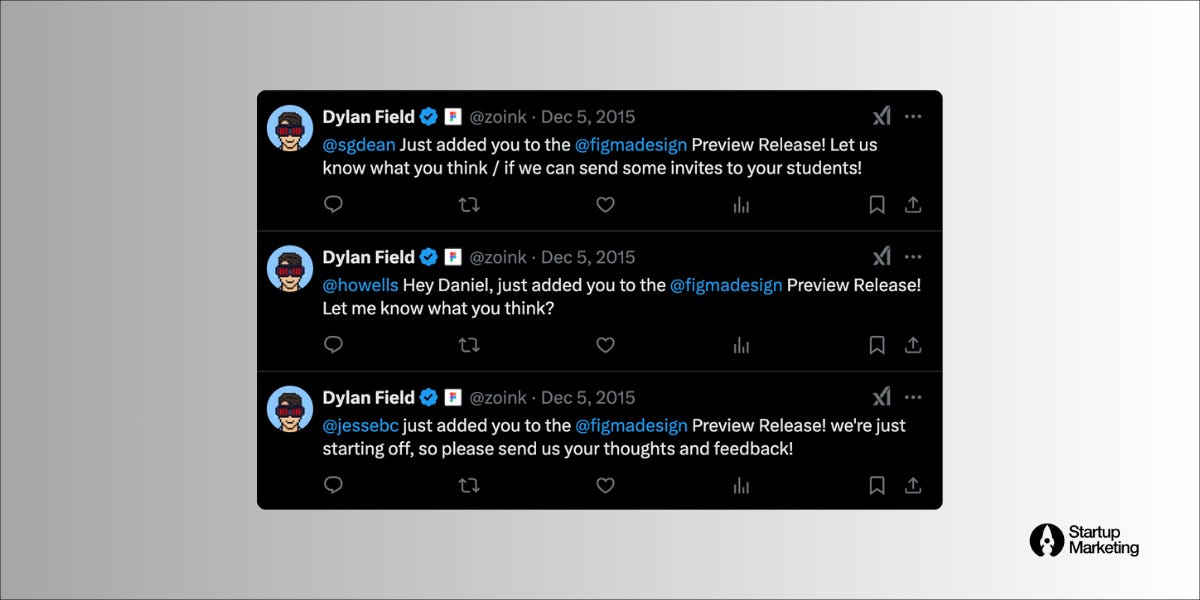Figma's $0 to $1 Million ARR Marketing Strategy
A deep-dive into Figma's community-led growth strategy that helped them grow to $1M ARR.
👋 Hey, it’s Elan. Welcome to my weekly newsletter, where every week I pick one successful SaaS startup and break down how it grew from $0 to $1 million in ARR. I specifically focus on their marketing strategies - where they started, what worked, and how they executed it.
This week, I covered Figma in the $0 to $1 Million Marketing series. Figma’s growth has been largely driven by its community, and in this edition, we explored exactly how they executed those strategies.
If you're getting started with marketing your product or considering building a community around your brand, Figma’s community-led growth story offers plenty of inspiration and valuable insights.
About Figma
Figma is a collaborative design tool founded in 2012, and they did their closed beta launch three years later on 3 December 2015. Figma did a public launch in 2016 - a year later than the beta launch. For the first 2 years, they haven’t charged anybody, and they introduced pricing plans by early 2017. Figma hit their $1 million soon after the paid plans were introduced.
The more I learnt about Figma, the more I started to love the brand and product for its contribution to the design world. Figma changed the way designers worked with developers, product managers, and marketers forever.
I don’t want to sidetrack any further, so let’s deep dive into what really helped Figma to disrupt the well-established and crowded design tools market.
Understanding the Target Audience
Figma’s success lies in its deep understanding of their target market and users, gained through extensive research, user interviews, and direct community engagement. It was explicit in everything they did in the initial 3-5 years. What did they understand about designers?
Designers are particular about their tools as they spend a lot of time using design tools.
Changing a design tool is like changing habits for a designer.
Designers want to understand how technical features work and how they can use them.
Designers deeply care about the craft and want to learn the best ways to improve their craft.
Designers naturally collaborate and work with many people.
These insights shaped Figma's go-to-market strategy.
Figma’s Marketing Strategy
With the clear understanding of their target market, Figma focused on a bottom-up, community-led marketing strategy that prioritized individual designers and their needs.
Bottom-Up Marketing Approach
Bottom-up strategy is when you target the end users rather than the decision makers. Right from the get-go, Figma focused on building a relationship with designers through community engagement.
We called it product-led, we called it community-led. The way I think about it now is this bottoms-up motion, that really is focused on ICs. So it's all focused on like, "Okay, so you have this core audience." For us it was designers.
- Claire Butler, Figma’s First Marketing Hire
Figma took it as a mission to make designers love the tool.
Community Engagement
Figma adopted a community-led growth approach, allowing them to stand out in a crowded market and make a significant impact. It helped Figma to cultivate a passionate user base that drove product adoption.
Community Platform
In the initial days, building your own community is not possible, especially when nobody knows about you. Community is all about credibility, trust, and authenticity. As a new folk in the block, you can’t expect people to flock to your community. Figma understood it early and focused on engaging with well-established design communities both online and offline.
Twitter design community existed without us. That was there before we were there. So, it made it a lot easier for us to get started, because we didn't have to make something to bring people to us. We had a distribution channel already in place that we could work through. That helped a ton.
- Claire Butler
They found most designers were active in X and it became Figma’s primary communication channel to engage with the design community. And they do it till date.
Stealth Mode Interviews and Demos
Right from stealth mode, Figma started engaging with the design community through meetups and in-person interviews. In the initial days, they focused on gathering feedback and building relationships with potential users. Dylan Field (CEO, Figma) and Claire (First marketing hire) got introduced to designers through the community engagement and existing network. They conducted in-person interviews with design teams at various companies. In these interviews, they identified people who are excited about the product and onboarded them as early adopters.
Design Meetups
I could categorize the meetups pre and post-launch. Where they used meetups as one of the key community engagement activities.
Before the launch, Figma brought together a community of design systems people, meeting with their product team and Dylan Field, to have informal meetups around design systems to learn from these people and start learning and hearing from them.
The meetups continued post-launch as well but with different themes:
Inspect (Design Critique Session)
Office Hours (inviting designers to the office)
Ping Pong (Designing Competition)
Shindigma (Design Systems Meetup)
Hosting Summer Interns
These meetups helped Figma build affinity for their product where it created an opportunity for designers to meet and interact with the team behind Figma. The more designers learnt about the team and Figma’s, the more they felt valued, invested, and understood.
Hiring Designer Advocates
Figma took the community-first approach to a different level by hiring designer advocates to connect with users, represent them, create content, and bring feedback to the product team.
Figma's designer advocates were passionate users and technical experts and were often product designers before becoming advocates. They often emerged from the community organically. Designer advocates helped Figma build authenticity with people.
Having designer advocates helped Figma with multiple aspects:
It helped them communicate with their target users more effectively as designers know designers better than marketers.
Having designers fronting your marketing enables you to build a community faster.
Sales deals were more likely to close when the designer advocates joined the calls as they were able to explain the product and its features more effectively to users.
As Figma scaled, it also developed developer advocates, FigJam advocates, and regional advocates.
Content Strategy
Figma's content strategy was the opposite of the "how-to" content that other companies like HubSpot were putting out at the time. Instead, Figma prioritized in-depth technical content to showcase the product's engineering and design decisions.
Traditional product marketing kind of stuff just doesn't work. Designers wanted to hear technical features. They wanted to understand how technical features work. They want to hear, "How am I going to use this?"
- Claire Butler
Technical Content Focus
Recognizing that designers have a "high bullshit meter" and don't want to be marketed to, Figma avoided traditional marketing. Instead, they focused on churning out highly technical and educational content for designers that helped them to improve their craft and adapt the tool.
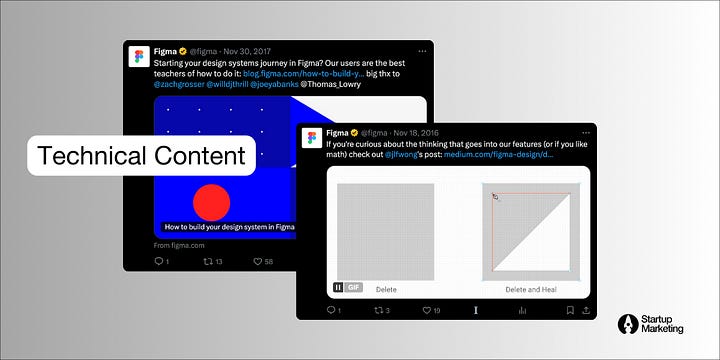
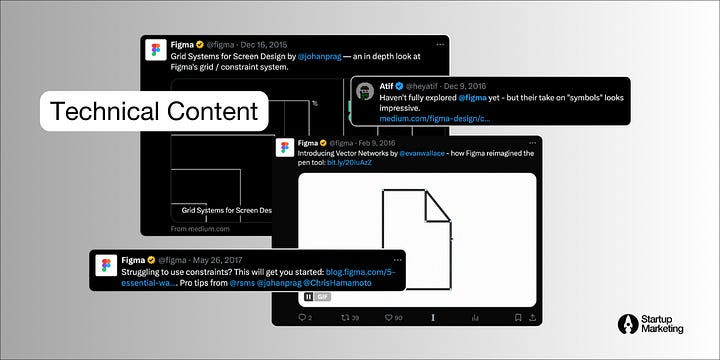
Hired designers who are good writers to write about their methods, tips, ideas, and design techniques.
How technical features worked and how users could implement them.
Figma shared deep dives into the product decisions, including the craft decisions that went into it.
Figma used its own design team (its target audience) to present how features were built and the choices behind them.
Figma would share information on small updates that would impact a designer's quality of life.
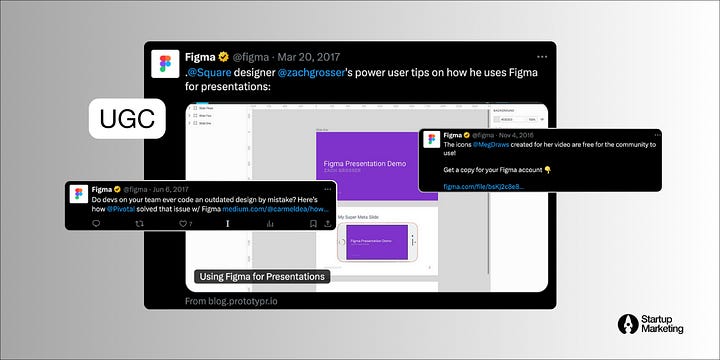
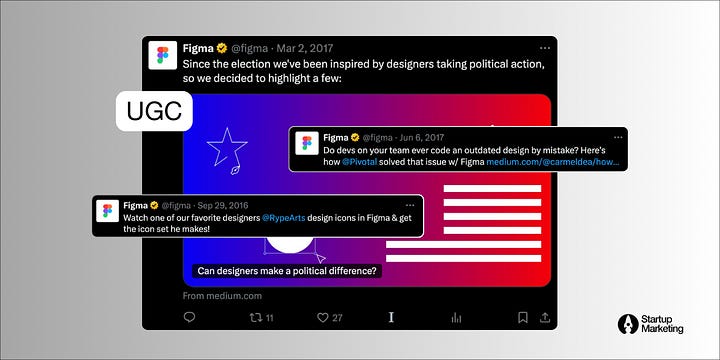
In addition, Figma started encouraging user-generated content by resharing content created by designers about how they solved a specific challenge using Figma and user-created templates/icons. It helped the Figma user community to make the most out of the tool.
Growth Tactics
Figma team used every possible angle to reach design folks with a large audience. It used a range of growth tactics, especially in the early stages, that contributed to its success.
Engaging Design Influencers on Twitter
During the launch, Figma approached Twitter marketing more analytically. They didn’t take a spray and pray approach, instead took a very systematic approach to gain maximum reach within the design communities on Twitter.
Designers hung out on Twitter, so I used a network visualization tool to find designers I was inspired by and mapped their networks. I emailed the designers, and most of the time, they were down to get coffee (especially if I was buying) and give feedback on the early product.
- Dylan Field, Co-Founder, Figma
For this, Dylan used a network visualization tool to identify key designers, who had larger influence in the Twitter design community. They then reached out to these influencers for feedback about Figma during the beta launch.
Student Outreach
As part of engaging with the design community, they’ve partnered with US Berkeley College. Most often students learn professional design through digital tools. So, it created a huge opportunity for Figma to get introduced among design-aspiring students very early in their professional cycle. When they learn design through Figma, they will get used to the tool and prefer Figma when they become professional UI/UX designers.
Freemium Model
At the time, the design tool market was crowded and Adobe was the goliath. Like I mentioned earlier, for designers, changing their designing tool is like changing their habits. So, Figma’s initial goal was to have designers use their tool at least for their personal and freelance projects. For designers, experimenting with a new tool had only two frictions: behavioural change and money.
If folks weren’t ready to use Figma full-time in their day job, they could use Figma for free for a side project. You could use the tool in a lower-stakes way and come back to Figma repeatedly over time.
- Claire Butler
To reduce this friction, Figma launched as a free tool and did not introduce a paid plan until 2017 i.e. two years after launching out of stealth. At that point, most users became internal champions for Figma at their organizations and did self-purchases.
Inbuilt Virality
Figma’s key differentiated feature of collaboration enabled it to leverage the core characteristic of designers. Designers are naturally collaborative and work with many people, making it easier for them to spread the tool.
Figma's free tier allowed users to invite unlimited collaborators. A free tool with high collaboration possibilities is a recipe for viral growth.
The other attribute is, designers typically wanted to express themselves and showcase their work. Designers who got beta access started playing around with the tool and posted designs they created with Figma.
Product Updates as Launches
Figma continued to keep the Twitter community up-to-date with the latest product updates and they continue to do it to this day. In the closed beta phase, they treated every new update as a big launch where they actively shared release notes, how to use it, and how it will benefit the users. It created hype and curiosity which drew a new bunch of designers asking to get their hands on Figma.
Conclusion
This is the third case study I wrote, and one key takeaway from Figma’s strategies is that in the early days, focusing on things that won’t scale - like deeply engaging with the community, building strong relationships, and consistently delivering value - can set the foundation for long-term success.
Figma made community-led as its DNA and it was resonating in every decision they made around product, sales, marketing, and customer support. Right from hiring designer advocates, creating technical content, conducting meetups, and using Twitter as their primary communication channel.




